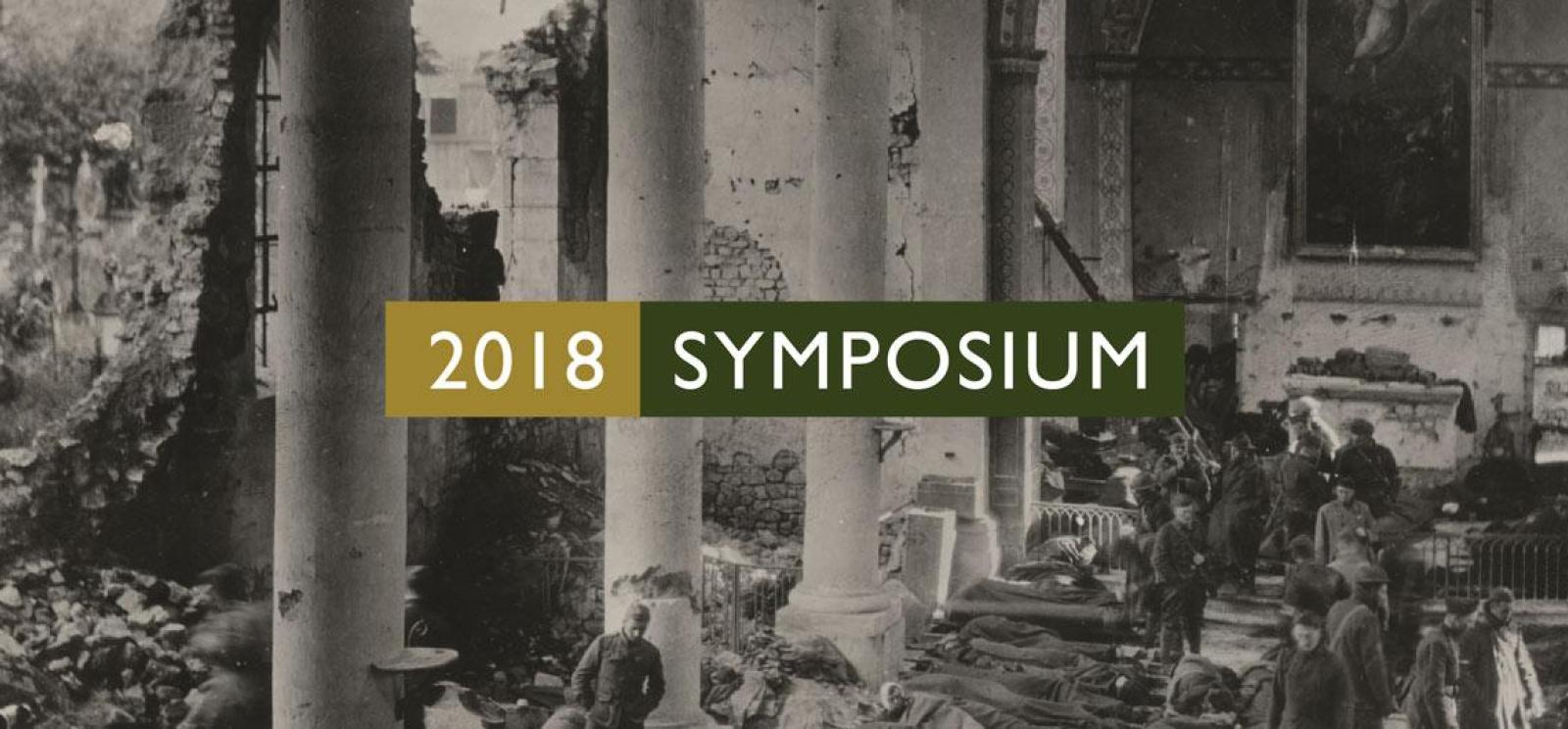Explore the irrevocable changes years of cataclysmic conflict wrought on the global stage. Discover the complex impact on familiar structures as war was fought on three diverse continents of battlefields and the waters that connected them to the American homefront. As borders were literally and figuratively redrawn, Allies celebrated a victory and the world came to terms with the irreparable devastation and losses of the “war to end all wars.”
Watch the Presentations from 1918: Crucible of War on YouTube
Presenters
Michael Hankins
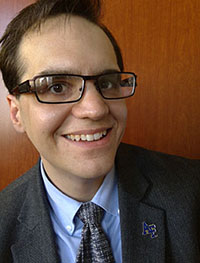
“The Fighter Pilot with a Thousand Faces: The Birth of the Knights of the Air”
The airplane began the First World War as primarily a reconnaissance tool, but through the years of bitter fighting, it evolved quickly. By 1918, aircraft in many shapes and sizes performed a variety of roles including bombing, ground support, interdiction and air-to-air combat. Intertwined with this evolution in technology was a similar evolution in culture. Pilots that focused on “pursuit” (air-to-air combat), began developing their own subculture. Partly as a response to the bleak conditions of trench warfare on the ground, pursuit pilots valued their independence and aggressiveness, and tended to see themselves as heroes in the mold of Greek myths or medieval knights. This culture was a constructed abstraction of reality. For some it was a veneer to cover the fears associated with flying, or the pain of losing comrades, and in some cases it was an accurate reflection of individual personalities. For all involved, this culture—itself a romanticization of reality—was a call back to a romanticized past. Yet it was powerful force that both brought pursuit pilots together and separated them from other types of fliers and soldiers. The main tenets of the subculture of the “knights of the air” that was formed in the First World War have been passed down through the decades and remain the key elements of fighter pilot culture 100 years later.
Biography
Dr. Michael Hankins is Assistant Professor of Strategy at the U.S. Air Force's eSchool of Graduate PME, the distance learning component of the Air Command and Staff College. There, he directs courses on air power history and national strategy. Previously, he was an Instructor of Military History at the U.S. Air Force Academy. He is currently composing a book that explores the relationship between pilot culture and the technological development of military aircraft, and he recently published an article, “The Teaball Solution: The Evolution of Air Combat Technology in Vietnam, 1968-1972,” in the Air Power History journal. He earned his PhD from Kansas State University in 2018 with his dissertation, “The Cult of the Lightweight Fighter: Culture and Technology in the U.S. Air Force, 1964-1991.” He completed his master’s degree at the University of North Texas in 2013 with his thesis: “The Phantom Menace: The F-4 in Air-to-Air Combat in the Vietnam War.”
James Holmes

“Refuse to Be a Control Freak: The Royal Navy's Failure at Jutland (and What the U.S. Navy Can Learn from It Today)”
Historian Andrew Gordon warns that Great Britain's Royal Navy spent the century after its smashing triumph at the Battle of Trafalgar (1805) in the "long calm lee" of victory. But the lee is a false calm. It only provides temporary protection from the elements. Nevertheless, a long calm lee may lull us into believing that calm seas are the natural state of things, and thus that we no longer need to prepare for heavy weather. The Royal Navy faced no serious challenger until the rise of the German Kaiser's High Seas Fleet around the turn of the 20th century. With no potential foe to keep them sharp, British naval commanders fell into all manner of bad habits. In particular, they took to choreographing fleet movements in minute detail—denying ship captains the liberty to act independently in battle. In short, they sapped initiative from the British fleet, leaving it ill-equipped for the chaos of combat at Jutland (1916). No script for military action survives first contact with the enemy, and the Royal Navy forgot that basic fact.
The U.S. Navy has enjoyed a long calm lee of its own, having fought its last major fleet battle at Leyte Gulf in 1944. U.S. naval leaders have succumbed to similar vices. The naval service thus has much to learn from World War I at sea as it returns to great-power strategic competition—competition that could involve future Jutlands.
Biography
Dr. James Holmes is J. C. Wylie Chair of Maritime Strategy at the Naval War College. He previously served on the faculty of the University of Georgia School of Public and International Affairs. A former U.S. Navy surface warfare officer, he served as an engineering and gunnery officer in the battleship Wisconsin. He was the last gunnery officer in history to fire a battleship's big guns in anger, off the Kuwaiti coast in 1991. Jim is a graduate of Vanderbilt University, Salve Regina University, the Naval War College, Providence College, and the Fletcher School of Law and Diplomacy at Tufts University. His latest book is the second edition of Red Star over the Pacific, newly in print this fall. The Atlantic Monthly named the first edition a Best Book of 2010. Secretary of Defense Jim Mattis calls him "troublesome."
David Kennedy
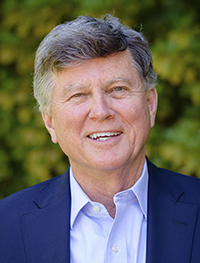
“Rallying Americans for War, 1917-1918”
America’s engagement in World War I was like that of no other major belligerent. The United States entered the war late, saw no bloodshed on its own soil, mobilized rapidly but only partially, and fought its major battles only in the war’s closing weeks. The totality of that experience tells us much about the nation’s geopolitical position in the early twentieth century, both before and after the conflict, about the nature of the progressive movement that the war allegedly snuffed out, and about some enduring aspects of the American national character.
Biography
David M. Kennedy is the Donald J. McLachlan Professor of History Emeritus and Director Emeritus of the Bill Lane Center for the American West at Stanford University. For more than four decades he has taught the history of the twentieth-century United States, American political and social thought, foreign policy, literature, and the comparative development of democracy in Europe and America. Reflecting his interdisciplinary training in American Studies, Dr. Kennedy's scholarship integrates economic and cultural analysis with social and political history and focuses on the study of the American national character. He is the author of the Pulitzer Prize Finalist Over Here: The First World War and American Society, in addition to Birth Control in America: The Career of Margaret Sanger, Freedom from Fear: The American People in Depression and War, 1929-1945 and most recently, The Modern American Military.
He has served as chair of the Stanford History Department, and as director of Stanford's Program in International Relations, as well as Associate Dean of the School of Humanities and Sciences. He has also served as an advisor for PBS’s The American Experience and for the History Channel’s History of US, in addition to Director of The Bill Lane Center for the American West, Kennedy has become increasingly engaged with a range of issues affecting the western region, including water, energy, climate change, demographic shifts, governance, bio-diversity and the future of the national parks.
Robert Laplander
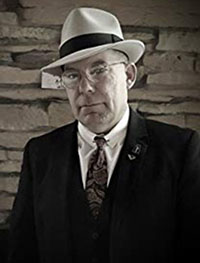
“Hell's Half Acre - The True Story of the Lost Battalion”
On the evening of Oct. 2, 1918, Major Charles W. Whittlesey of the 77th Division led nearly 700 men under his command into the narrow Charlevaux Ravine, deep in the heart of the Argonne Forest in northeastern France. That night the German occupied the high ground behind them, surrounding them and cutting them off a kilometer ahead of the American lines. Five days later, just 194 survivors walked out of the ravine... and into history. This is their story.
Biography
The activities of the 1st Corps of the American 1st Army during the Meuse-Argonne Offensive has been a life-long passion for author and historian Robert J. Laplander. Based upon his 20 years of research into the Lost Battalion of the 77th Division, he wrote Finding the Lost Battalion: Beyond the Rumors, Myths and Legend of America’s WWI Epic. Laplander was featured in the television event, The Great War, part of the PBS American Experience series, which coincided with the centennial anniversary of the United States’ entry into World War I. Laplander has been featured on multiple radio platforms including Federal News Radio, ABC News Radio and CBS News Radio and provides professional development lectures for the U.S. Army. He is also a partner in the U.S. WWI Centennial Commission, managing both Doughboy MIA, a site which tracks mission U.S. service personnel from the war and The Lost Battalion portion of the Commission’s online presence.
Adriane Lentz-Smith
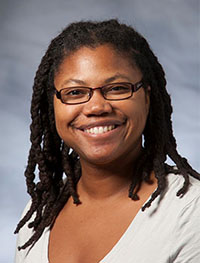
“Jim Crow Shell Shock: African Americans and the Crucible of World War I”
When historian and veteran officer Rayford Logan thought back on his service in World War I, he claimed that he had fought two wars at once—his and Woodrow Wilson’s—and that he could not say which war had marked him more. Many activists followed Logan in narrating the war as a political coming of age, and many would bear its scars both physical and emotional. Placing the war within the broader narrative of the black freedom struggle, this session considers what the war did to and for African Americans who saw it as a turning point in their fight against white supremacy.
Biography
Dr. Adriane Lentz-Smith is Associate Professor of History, African & African-American Studies, and Gender, Sexuality & Feminist Studies at Duke University. She specializes in 20th century African American history and histories of the United States and the world. Her book, Freedom Struggles: African Americans and World War I (Harvard, 2009), explored the role of World War I in the Progressive-Era black freedom struggle. Her current book project, The Slow Death of Sagon Penn, examines state violence and the remaking of white supremacy during the Reagan-Era Cold War. A Ford Foundation fellow, Lentz-Smith holds a BA in History from Harvard-Radcliffe and a PhD in History from Yale University.
David Lubin
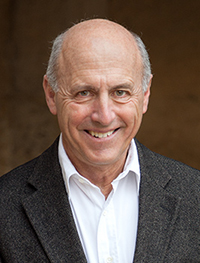
“Flanders in Flames: Belgium in the American Imagination, 1914-1919”
As a symbol of innocence defiled by barbarism, Belgium figured mightily in the imaginations of Americans when they considered whether or not their nation should declare war on Germany. Even after the declaration, with the United States focusing its military attentions on France, Flanders stirred the emotions as a signifier of both abject victimhood and staunch resistance. This lecture will explore Belgium as a recurring trope in imagery by some of America’s finest painters and illustrators, among them the avant-garde modernist Man Ray, the social realist George Bellows, and the venerated Anglo-American portraitist John Singer Sargent, who borrowed from the sixteenth-century Flemish master Pieter Bruegel to comment on the folly and tragedy of war in 1918.
Biography
David Lubin is the Charlotte C. Weber Professor of Art at Wake Forest University. In 2016-7 he was the inaugural holder of the Terra Foundation Visiting Professorship of American Art at Oxford University. His books include Picturing a Nation: Art and Social Change in Nineteenth Century America (Yale University Press, 1994) and Shooting Kennedy: JFK and the Culture of Images (University of California Press, 2003), which received the Smithsonian Institution’s Eldredge Prize for distinguished scholarship in American art. His most recent publication is Grand Illusions: American Art and the First World War (Oxford University Press, 2016; paperback 2018). Lubin co-curated the acclaimed exhibition World War I and American Art for the Pennsylvania Academy of the Fine Arts, and he has lectured at universities and art museums throughout the United States, Europe, China and Australia on American art of the WWI era.
Brian L. Steed
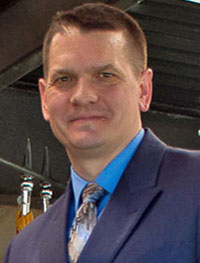
“Armageddon and the Modern Middle East”
ISIS fighters schooled a Vice reporter about the importance of destroying the Sykes-Picot borders as a bulldozer created a passable lane in a large sand berm on the Iraq-Syria border. In describing what was happening, the fighter did not call the different countries Iraq and Syria as those were terms created after the collapse of the Ottoman Empire and the redrawing of the Middle East map. The agreements, treaties and actions in 1918 and the years that followed created the states that currently exist in the Middle East and, by so doing, created many of the problems present in the region. These agreements were won by force of arms, political intrigue and disregard for the interests of the local tribal, ethnic and religious sectarian divisions throughout the region. Current fighting in Syria and northern Iraq are reminiscent of those days at the end of and in the years following World War I.
Biography
Brian L. Steed is a senior fellow with Narrative Strategies. He is a retired U.S. Army Lieutenant Colonel, an assistant professor of military history at the U.S. Army Command and General Staff College and a former Middle East Foreign Area Officer. He served eight and a half consecutive years in the Middle East including an assignment as an officer in the Jordanian Armed Forces—the very force drawing its lineage from the great Arab Revolt of World War I. He has written numerous books on military theory and military history and cultural awareness. His most recent published books include ISIS: An Introduction and Guide to the Islamic State, Voices of the Iraq War: Contemporary Accounts of Daily Life (Voices of an Era) and Bees and Spiders: Applied Cultural Awareness and the Art of Cross-Cultural Influence . Since returning from Iraq in March 2015 he has been speaking on understanding ISIS in their cultural and historical context. His website narrativespace.net features information and recommendations for better understanding ISIS, the Middle East and contemporary conflict. He is currently a PhD student at the University of Missouri-Kansas City, where he is working on a dissertation focused on the role of narrative and modern conflict.
Graydon Tunstall
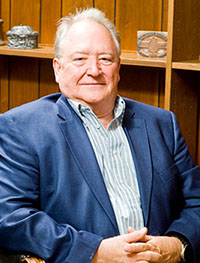
“1918: The Other European Fronts – Eastern, Italian and Balkan”
The situation in Russia after the Kerensky Offensive and the November Revolution led into the negotiations for the Brest-Litovsk Treaty, followed by the German invasion of the Ukraine and the Baltic region. This presentation discusses the social-economic-political and military collapse of Austria-Hungary as well as a review of the major events on the Italian front followed by a discussion of the collapse of the Balkan front in September 1918 and its effects on the outcome of the war.
Biography
Dr. Graydon Tunstall recently retired as Senior Lecturer of History at the University of South Florida and the Executive Director for Phi Alpha Theta National History Honor Society. Tunstall holds a PhD in Modern European History from Rutgers University and has lectured at the United State Military Academy at West Point. He has authored a number of books and articles including Blood in the Snow: The Carpathian Winter War of 1915, published by University Press of Kansas, which received Honorable Mention for the Western Front Association’s Tomlinson Book Award and was a featured selection in the Military History Book Club. Tunstall’s most recent work, Written in Blood. The Battle for Fortress Przemyśl 1914-1915, published by Indiana University Press, was the co-award winner for the Western Front’s 2016 Tomlinson Book Award. He is currently working on a monograph entitled Austria-Hungary in World War I, which will be published by Cambridge University press next year. He has been a board member of the World War One Historical Association for several years.
Kara Dixon Vuic

“A New Kind of Woman is Following the Army: American Women in the Great War”
In April 1918, a young woman from Montclair, N.J., sailed to France to begin work as a canteen worker for the YMCA. From the early days of American involvement in the Great War, she had wanted to do her part and even confessed that she wished that she “had been a man to have a small part in this great conflict.” This presentation considers the experiences of the 3,500 women like her who served coffee and donuts to doughboys across France, and in the process, began a long history of American women going to war to bring a bit of home to the front lines.
Biography
Dr. Kara Dixon Vuic is the LCpl Benjamin W. Schmidt Professor of War, Conflict, and Society in Twentieth-Century America at Texas Christian University. Her book The Girls Next Door: American Women and Military Recreation, will be published by Harvard University Press in early 2019. She is also the author of Officer, Nurse, Woman: The Army Nurse Corps in the Vietnam War and the editor of The Routledge Handbook on Gender, War, and the U.S. Military.
Geoffrey Wawro
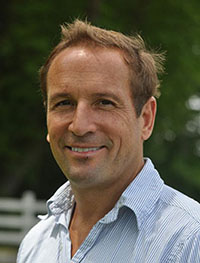
“How the U.S. Army Won World War I”
The Allies were on the brink of defeat in 1917. Russia and Italy were beaten, and the French and British reverses on the Chemin des Dames and Passchendaele led to the French army mutiny—never entirely solved—and a British manpower crisis as extreme as the French. Had the U.S. not intervened in 1917, the Germans might not have launched their 1918 offensives on the Western Front. They would have forced the Allies to attack the Hindenburg Line and exhaust the last of their manpower or accept German annexation of Belgium and northern France. However, with the Americans coming in force in 1918, the Germans had to attack. They nearly broke through to Calais and Paris. It was the Americans who saved the crumbling French army in the Second Battle of the Marne, and it was the Americans who delivered the decisive blow that won the war: the offensives at Saint-Mihiel and the Meuse-Argonne, which cut the principal German line of supply and retreat and forced Hindenburg's surrender in November 1918.
Biography
Dr. Geoffrey Wawro is Professor of History and Director of the Military History Center at the University of North Texas and was previously Professor of Strategic Studies at the U.S. Naval War College from 2000-05. Wawro is the author of six books, including his most recent, Sons of Freedom: The Forgotten American Soldiers Who Defeated Germany in World War I. He also authored A Mad Catastrophe: The Outbreak of World War I and the Collapse of the Habsburg Empire, Quicksand: America's Pursuit of Power in the Middle East, The Franco-Prussian War, Warfare and Society in Europe, 1792-1914 and The Austro-Prussian War.
Wawro is co-editor of the 30-plus volumes in the Cambridge Military Histories and is a member of the History Book Club Review Board. He has published articles in The Wall Street Journal, The Journal of Military History and The Naval War College Review as well as op-eds in the Los Angeles Times, New York Post and Miami Herald. Wawro has won several prizes, including the Austrian Cultural Institute Prize and the Society for Military History Moncado Prize for Excellence in the Writing of Military History. From 2000-09, Wawro anchored various shows for The History Channel and continues to work as an on-camera expert for History, Discovery, Smithsonian, American Heroes, National Geographic, Netflix and other channels.
WHO SHOULD ATTEND?
All who have a general to professional interest in the periods prior to, during and after World War I. We especially recommend this symposium to educators, historians and members of organizations that study these periods and/or engaged in planning projects and programs for the war’s centennial. Are you a member of the World War One Historical Association? As a partnering organization, their annual meeting and other great opportunities coincide with this symposium.
SYMPOSIUM FEE
The registration for the symposium is:
$195 early bird pricing (Deadline Sept. 24, 2018 extended to Oct. 5, 2018)
$245 per person (After Oct. 5, 2018)
Refund policy
The Museum and Memorial will honor a 50-percent refund on registration fees until Sept. 24. After Sept. 24, no refunds will be granted. Attendees may contact Mark Gunter at 816.888.8103 to request a refund.
OVERVIEW SCHEDULE
Thursday, November 1
10 a.m.- 5 p.m. Museum and Memorial Open
3-5 p.m. Check-in at Museum and Memorial
6:45-8 p.m. Opening Reception
Friday, November 2
10 a.m.- 5 p.m. Museum and Memorial Open
7:30- 8 a.m. Shuttle service from the Marriott Hotel to the Museum and Memorial
8-8:30 a.m. Check-in for attendees at the Museum and Memorial
8:30-8:45 a.m. Welcome: Dr. Matthew Naylor
8:45-9:45 a.m. Session: “How the U.S. Army Won World War I,” Geoffrey Wawro
9:45-10 a.m. Break
10-11 a.m. Session: “Refuse to Be a Control Freak: The Royal Navy's Failure at Jutland (and What the U.S. Navy Can Learn from It Today),” James Holmes
11 a.m.-noon Session: “A New Kind of Woman is Following the Army: American Women in the Great War,” Kara Dixon Vuic
Noon-1:30 p.m. Lunch at the Museum and Memorial
12:45-1:15 p.m. Book signing
1:30-2:30 p.m. Session: “Hell's Half Acre - The True Story of the Lost Battalion,” Robert Laplander
2:30-3:30 p.m. Session: “Jim Crow Shell Shock: African Americans and the Crucible of World War I,” Adriane Lentz-Smith
3:30-3:45 p.m. Break
3:45-4:45 p.m. Session: “The Fighter Pilot with a Thousand Faces: The Birth of the Knights of the Air,” Michael Hankins
5-5:30 p.m. Shuttle Service from the Museum and Memorial to the Marriott Hotel
6:30-7:30 p.m. Cocktail hour at the Marriott Hotel
7:30-9:30 p.m. Dinner and Lecture: “Flanders in Flames: Belgium in the American Imagination, 1914-1919,” David Lubin
Saturday, November 3
10 a.m.- 5 p.m. Museum and Memorial Open
7:30-8 a.m. Shuttle service from the Marriott Hotel to the Museum and Memorial
8:30-9:30 a.m. Session: “Armageddon and the Modern Middle East,” Brian L. Steed
9:30-9:45 a.m. Break
9:45-10:45 a.m. Session: “1918: The Other European Fronts – Eastern, Italian and Balkan,” Graydon Tunstall
10:45-11:45 a.m. Session: “Rallying Americans for War, 1917-1918,” David Kennedy
11:45 a.m.-1 p.m. Lunch at the Museum and Memorial
12:30-1:30 p.m. Shuttle service from the Museum and Memorial to the Marriott
3:30-4 p.m. Shuttle service from the Museum and Memorial to the Marriott
Non-Symposium attendees may purchase tickets to attend the Friday evening dinner/presentation.
HOTEL INFORMATION
A discounted block of rooms is set aside at the Kansas City Marriott Country Club Plaza. Please use this link to book your room at the special rate of $149 per night (pre-tax) or contact the hotel for further information. To receive the special rate, reservations must be completed by Oct. 11, 2018.
Presenting Sponsor

The Symposium is made possible by the additional generous support of the U.S. World War One Centennial Commission, the General Delegation of the Government of Flanders to the USA, and Bill and Laura Frick. We extend our thanks to our program partners the World War One Historical Association and the Command and General Staff College Foundation, Inc.
Curious about the Museum and Memorial's Symposiums?
Watch videos of the presentations from past symposiums, 1917: America Joins the Fight, 1916: Total War, 1915: Empires at War, Churchill's Gallipolli and an America Divided and 1914: Global War and American Neutrality on YouTube.
